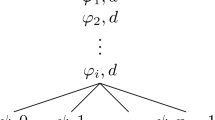Abstract
In this work we propose a labelled tableau method for Łukasiewicz infinite-valued logic L ω. The method is based on the Kripke semantics of this logic developed by Urquhart [25] and Scott [24]. On the one hand, our method falls under the general paradigm of labelled deduction [8] and it is rather close to the tableau systems for sub-structural logics proposed in [4]. On the other hand, it provides a CoNP decision procedure for L ω validity by reducing the check of branch closure to linear programming
Similar content being viewed by others
References
Aguzzoli, S., and A. Ciabattoni, ‘Finiteness in infinite-valued Łukasiewicz Logic’, Journal of Logic, Language and Information 9:5–29, 2000.
Avron, A., ‘Natural 3-valued Logics. Characterization and Proof Theory’, Journal of Symbolic Logic 56:276–294, 1991.
Ciabattoni, A., D. Gabbay, and N. Olivetti, ‘Cut-free proof systems for logics of weak excluded middle’, Soft Computing 2:147–156, 1999.
D'Agostino, M., and D. Gabbay, ‘A generalization of analytic deduction via labelled deductive systems I: basic substructural logics’, Journal of Automated Reasoning, 13:243–281, 1994.
D'Agostino, M., D. Gabbay, and K. Broda, ‘Tableau methods for substructural logics’, in: M. D'Agostino et al. (eds.): Handbook of Tableau Methods. Kluwer Academic Publishers, Dordrecht, pp. 469–528, 1999.
DoŠen, K., ‘Sequent systems and grupoid models II’, Studia Logica 48:41–65, 1989.
Fine, K., ‘Models for entailment’, Journal of Philosophical Logic 3: 347–372, 1974.
Gabbay, D., Labelled Deductive Systems (vol I), Oxford Logic Guides, Oxford University Press, 1996.
Godo, L., and F. Esteva, ‘Monoidal T-norm based logic: Towards a logic for left-continuous T-norms’, Fuzzy-Sets and Systems: 124: 271–288, 2001.
HÄhnle, R., Automated Deduction in Multiple-valued logic. Oxford University Press, 1993.
HÄhnle, R., ‘Many-valued logic and mixed-integer programming’, Annals of Mathematics and Artificial Intelligence 12: 231–264, 1994.
HÄhnle, R., ‘Tableaux for many-valued logics’, in: M. D'Agostino et al. (eds.): Handbook of Tableau Methods. Kluwer Academic Publishers, Dordrecht, pp. 529–580, 1999.
HÁjek, P., Metamathematics of Fuzzy Logic, Kluwer Academic Publishers, Dordrecht, 1998.
HÖhle, U., ‘Commutative, residuated l-monoids’, in: U. Höhle and P. Klement (eds.): Nonclassical logics and their applications to fuzzy subsets. Kluwer Academic Publishers, Dordrecht, pp. 53–106, 1995.
Jeroslow, G., Logic-Based Decision Support. Mixed Integer Model Formulation, Elsevier, Amsterdam, 1988.
Łukasiewicz, J., Tarski, A., ‘Untersuchungen über den Aussagenkalkül’, Comptes Rendus des séances de la Société des Sciences et des Lettres de Varsovie Classe III, 23:30–50, 1930.
Miglioli, P., U. Moscato, and M. Ornaghi, ‘An improved refutation system for intuitionistic predicate logic’, Journal of Automated Reasoning, 13(3): 361–374, 1994.
Mundici, D., ‘Satisfiability in many-valued sentential logic is NP-complete’, Theoretical Computer Science, 52:145–153, 1987.
Mundici, D., and N. Olivetti, ‘Resolution and model building in the infinite-valued calculus of Łukasiewicz’, Theoretical Computer Science, 200: 335–366, 1998.
Ono, H., and Y. Komori, ‘Logics without the contraction rule’, Journal of Symbolic Logic, 50: 169–201, 1985.
Ono, H., ‘Semantics for substructural logics’, in: P. Schroeder-Heister and K. Dosšen (eds.): Substructural Logics, pp. 259–291, Oxford University Press, 1993.
Ono, H., ‘Logics without contraction rule and residuated lattices'. To appear in R. K. Meyer Festschrift, 2001.
Prijatelj, A., ‘Bounded Contraction and Gentzen style Formulation of Łukasiewicz Logics’, Studia Logica, 57:437–456, 1996.
Scott, D., ‘Completeness and Axiomatizability in many-valued logic, in: Proc. of Tarski Symposium vol. XXV, AMS, pp. 411–435, 1974.
Urquhart, A., ‘Many-Valued logic’, in: D. Gabbay and F. Guenther (eds): Handbook of Philosophical logic, Vol. 3, pp.71–116. D. Reidel, Dordrecht, 1986.
Wagner, H., ‘A new resolution calculus for the infinite-valued propositional logic of Łukasiewicz’, Journal of Applied Non-classical Logic. To appear, 2002.
Author information
Authors and Affiliations
Rights and permissions
About this article
Cite this article
Olivetti, N. Tableaux for Łukasiewicz Infinite-valued Logic. Studia Logica 73, 81–111 (2003). https://doi.org/10.1023/A:1022989323091
Issue Date:
DOI: https://doi.org/10.1023/A:1022989323091




